Airfix 1/48 F-51D Mustang
The outbreak of the Korean War on June 25, 1950, found the United States less prepared to go to war than it had been on December 7, 1941.
The year before, the three fighter groups in the Far East had been re-equipped with the F-80 Shooting Star, and all but 47 of the F-51D Mustangs had either been junked, returned to the United States, or handed over to local air forces of allied countries in the region. Most of the 47 were used as “hacks” by the squadrons, useful for towing aerial targets and providing pilots with ground assignments the opportunity to get in sufficient monthly flight time to qualify for flight pay. All had been disarmed. Thirty of these Mustangs had been promised to the ROKAF in May, and there was even a group of American fighter pilots already in the country, assigned to train the South Korean pilots to fly the F-51. The F-80 could only operate from runways in Japan, since there were no paved runways in South Korea other than Kimpo Airport outside the capitol of Seoul, and thus had a “loiter time” over Korea of less than 30 minutes, with a reduced ordnance load to maximize fuel.
By the middle of the first week, all the F-51Ds in Japan had been gathered at Itazuke. Most were not ready for combat, having had their cockpit armor and machine guns removed when they were turned into squadron hacks. Every USAF pilot with Mustang experience was rounded up and assigned to the 35th Fighter-Bomber Squadron of the 8th Fighter-Bomber Wing, which was designated to re-equip with the “obsolete” F-51D, the only fighter-bomber in the inventory that could operate from the dirt strips in Korea.
On June 29, the F-51D scored its first aerial victories of the new war when four Mustangs escorted General MacArthur in his C-121 Constellation, “Bataan,” to Suwon to inspect the situation in Korea first-hand. While the general was on the field, several enemy aircraft were spotted approaching, and were intercepted at low level by the F-51s. Second Lieutenant Orrin R. Fox shot down two Il-10s, while 1st Lieutenant Harry L. Sandlin was credited with an “La-7" that was most likely a misidentified Yak-9 and 1st Lieutenant Richard L. Burns from the 35th FBS was credited with an Il-10. One of the Il-10s attempted to escape and was shot down by an F-80. General Stratemeyer later messaged the 8th wing that MacArthur had been “very impressed” with the result.
On July 5, nine high-time former Mustang pilots from the F-80-equipped 12th Fighter-Bomber Squadron of the 18th Fighter-Bomber Wing at Clark AFB in the Philippines formed what came to be known as “The Dallas Squadron.” After collecting Mustangs at Ashiya AFB in Japan on July 8, they moved to Taegu (K-2) airfield in South Korea, which had a PSP runway in a valley with mountains on either side. There they operated with the volunteer instructors of Major Dean Hess' “Project Bout One” and the combined unit was designated the 51st Fighter Squadron on July 10.
Dean Hess would become one of the best-known pilots of the Korean War, due to the 1956 publishing success of his book, “Battle Hymn,” and the subsequent 1957 movie adapted from the book, which starred Rock Hudson. An ordained minister who left his ministry and volunteered for the Army Air Forces after Pearl Harbor, Hess had flown 63 missions in P-47 Thunderbolts after the Normandy invasion. Recalled to active duty in 1948 where he served with the occupation forces in Japan in the 8th Fighter-Bomber Wing, he had taken the assignment to train RoKAF pilots in late May, 1950. His fame would come during the retreat out of North Korea following the intervention of Red China in the war, when he was able to organize the evacuation of several thousand Korean war orphans to safety on an offshore island.
While the Dallas Squadron was flying 426 sorties through the month of July in a desperate attempt to support UN forces in the face of the North Korean offensive, and the other fighter-bomber units worked to get up to speed in transitioning back to F-51s, Far East Air Forces put out a call to Air National Guard units in the United States to turn over their F-51s for use in the war. Mustangs were hurriedly removed from Air National Guard units throughout the continental United States and flown to the Alameda Naval Air Station in San Francisco Bay in early July.
USS Boxer (CV-21) had returned from her six month deployment to the Western Pacific only days before the outbreak of war and had already departed San Diego, headed for overhaul in Bremerton, Washington. The carrier was diverted to San Francisco, where she docked at Alameda Naval Air Station on July 8. She immediately loaded the 145 Air Force F-51Ds that had been rapidly cocooned for their trans-Pacific delivery on their arrival from the ANG units, six Stinson L-5 Sentinels, and 19 Navy aircraft. Conditions would be crowded aboard ship with the presence of 1,012 Air Force maintenance technicians and support personnel who came aboard along with 2,000 tons of crucial spare parts and ordnance.
On July 14, Boxer departed Alameda at 0800 hours. Once past the Golden Gate, her captain ordered the engine rooms to maintain Flank Speed for the duration of the voyage. The carrier set a trans-Pacific transit record of eight days and seven hours when she arrived at Yokosuka, on July 23. The Mustangs and their service personnel and supplies were quickly off-loaded; the first F-51 flew an air support mission a week later.
While Boxer was setting records delivering F-51s to Japan, the pilots of the 51st Fighter Squadron continued their fight against the enemy drive south in Korea. Major Harry H. Moreland, who had become the unit CO, remembered a mission flown shortly after arrival at Taegu in which they were requested by the Army to attack 20 railcars at Taejon filled with ammunition that had been left behind in the hasty retreat. Being unfamiliar with both the area and the Mustang after transitioning to the F-80 a year earlier, Moreland sent three two-ship flights in hopes one would find their way to the target. As it turned out, he and his wingman, 1st Lt. Howard “Scrappy” Johnson were the only ones to find their way through the valleys under the 700-foot overcast ceiling. “Once in the area, we located the railcars and proceeded to strike them with such accuracy that we managed to take out the entire lot. The resulting explosions were awesome with the sky lit up like the Fourth of July!”
On another mission running the road between Seoul and Taejon, Moreland spotted a haystack in a field with tread marks leading up to it. When he made a low-level pass, he was able to identify the enemy tank hastily covered by the hay. Having already dropped their napalm tanks on trucks they had run across, the two Mustang pilots only had their .50-caliber machine guns, which were insufficient to harm the tank. However, their gunfire did set the hay afire. “The flames literally cooked the tank as we circled and then there was a large explosion.” A few weeks later, Moreland established “Moreland's Tank Busters” within the 51st FS after they were able to obtain supplies of 6.5-inch tank-busting rockets capable of penetrating the armor of a T-34 tank. The flight was on call 24 hours a day and became the terror of North Korean armored units.
Among the pilots sent from the Philippines to form the “Dallas Squadron” was 1st Lieutenant Daniel “Chappie” James, who had graduated from Tuskeegee Institute and taken flight training as one of the Tuskeegee Airmen during World War II. His excellent flying skills resulted in his being held back as an instructor during the war for other African-American pilots in the program. He had served with the 332nd Fighter Group after the war until the armed services were desegregated in 1948, at which point he was sent to the Philippines to join the 18th Fighter-Bomber Wing at Clark AFB.
Moreland's wingman, 1st Lt. Howard “Scrappy” Johnson - who later broke the world altitude record flying an F-104 - remembered that Captain “Spud” Taylor and Chappie James formed the other element in Moreland's flight in the 51st FS. On one mission during the fighting along the Naktong River in defense of the Pusan Perimeter, the flight spotted several NKPA artillery pieces on a sand bar in the river. When they dropped their napalm cannisters, they failed to ignite due to bad fuses. “Every third round in our fifties was an incendiary, so we came around in a strafing run. The incendiaries set the cans off and the entire area went up in flames, completely destroying the cannons.”
During the fighting in the Pusan Perimeter in August, F-51Ds of the newly-re-equipped 8th and 35th Fighter-Bomber Wings flew missions from Itazuke to Korea, landing at Taegu to refuel and rearm to fly more missions during the day, returning to Japan at night.
Despite the Mustang's manifest unfitness in the ground attack role with its vulnerable radiator and liquid-cooled engine (one F-51 pilot remembered that every time he climbed in the cockpit “I prayed ‘Dear god, let this be a P-47!'”) the airplane was the primary USAF battlefield air support aircraft throughout the war until it was replaced by the F-86F-25 Sabre, which was equipped for the fighter-bomber role.
(Above history taken from my coming book, "MiG Alley: The U.S. Air Force in Korea")
THE KIT
Airfix first released its 1/48 Mustang in late 2017. This F-51D is the second of three releases, the first being a World War II P-51D, and the third being a P-51K/Mustang IV. This release has a separate sprue with six 5" HVAR rockets for underwing ordnance. Decals include an F-51D of the 67th Fighter-Bomber Squadron in 1951, an F-51D of the RAAF 77 Squadron from the summer of 1950, and a Swedish J-25 Mustang from 1951.
CONSTRUCTION
Taking my time, and fitting parts carefully (not to mention following the instructions) I had the kit assembled in five hours, with no filler anywhere. Parts fit is precise. Be sure you trim off all little “sprue nubs” since this kit is CAD designed and parts fit is precise. The instructions are clear and easy to follow.
I prepainted the cockpit parts flat black as almost all Korean War F-51 cockpit had been repainted after the war. I picked out detail with a white and a silver artist's pencil. Once assembled, the cockpit provides sufficient detail that when installed, I don't think you're really going to want to invest in a resin cockpit. I did, however, use Eduard photoetch seatbelts with this model.
The wing is easily constructed, and it is nice to see that the main gear well uses the main spar as the rear wall of the well throughout.
By providing two sets of flaps - one for “up, one for “down,” Airfix is able to offer flaps that in the “down” position do not have the “ledge” so familiar with the Tamiya kit. They have tabs that insure they're in the full-down position when installed.
Everyone normally has fits over getting the main gear legs positioned at the proper angle; failure to get it right is the major “fail” in Mustang models, even those built by “experts.” Airfix has designed this gear so that one sticks it in the hole and it is positioned at the right angle. No more hemming and hawing.
I filled the panel lines in the wings with CA-glue and sanded them smooth.
COLORS & MARKINGS
I first painted the wheel wells Interior Green, since F-51D-25 and later Mustangs had their wheel wells in this color at the factory, then proceeded to paint the model overall with Tamiya Semi-Gloss Black, thinned 50-50 and misted on to give as smooth a base coat as possible for applying the Vallejo metalizer paints. I masked off the anti-glare panel, then proceeded to paint the puttied wings with Vallejo “Dull Aluminum.” I waited a few hours for it to fully set, then had no trouble masking it with low-tack drafting tape. I then painted the rest of the model with Vallejo “Aluminum.” I painted the fabric-covered rudder with Vallejo “White Aluminum” to mimic aluminum lacquer. I hand-painted Vallejo “Duraluminum” on the cowling side panels. It is easy to do multi-hue finishes with Vallejo paints once the base coat is dry, applying the paint with a brush, since it dries without leaving brush marks in the paint.
I had been saving an old Aeromaster decal sheet that had Dean Hess' F-51D in ROKAF markings with the name “I fly by faith” in Korean on both sides of the cowling. Aeromaster provides ROKAF markings for six locations, but a quick Google for “photos of Korean War ROKAF F-51D” revealed that the insignia was only in two positions, and on the opposite wing to that of USAF insignia.
During the summer of 1950, with a shortage of ordnance in Korea, most Mustangs only carried four HVARs, so I cut the launchers off two of the rockets and then attached them and the other four rockets underwing. I used Tamiya 75-gallon drop tanks for the napalm tanks - these were painted yellow to distinguish them from regular fuel tanks.
I used the “open canopy” option Airfix provides, which is slightly larger than the “closed canopy” option and allows the canopy to be positioned on the fuselage correctly.
CONCLUSIONS
No, the new Eduard kit does not make the Airfix kit “obsolete.” In fact, if you sit one of each next to each other and look at them from the normal viewing distance of around 3-4 feet in normal light, it's hard to tell which is which, since the Eduard surface detail is so petite and light you can't see it under a coat of paint from farther away than 10-12 inches, and that under good light.
The Airfix kit does not provide all sub-type options in the kit, as the Eduard special release does. If you want to do a post-WW2 airplane or a late WW2 airplane armed with rockets, you have to get this release, the only one with that underwing ordnance. If you want a P-51K with the Aeroproducts prop, you will have to get the “Mustang IV” release. The Airfix kit assembles easier than the Eduard kit, a plus for less-experienced modelers who want a really nice result. It's also about half the price of the Eduard kit, a plus for those who want to do more than a few for the many markings options available for the P-51. The kit is still - Highly Recommended.
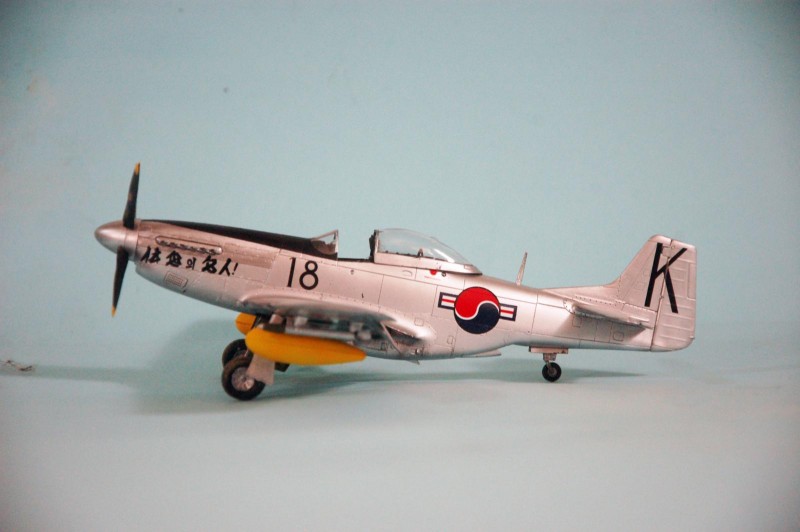
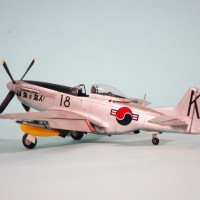
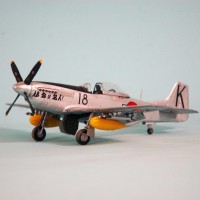
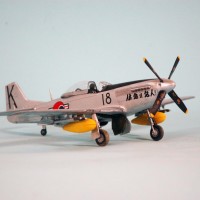
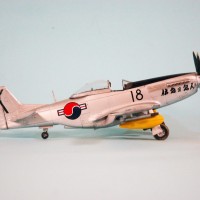
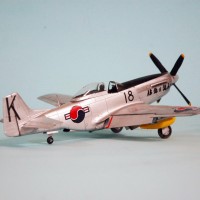
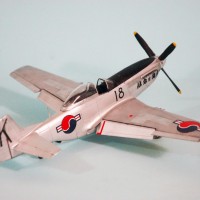
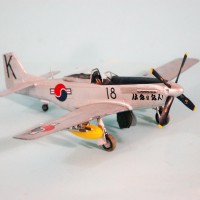
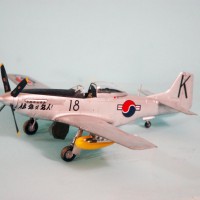
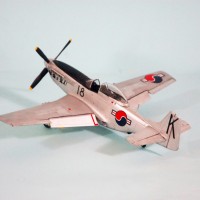
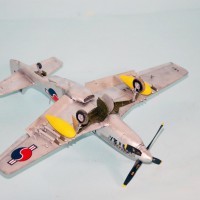
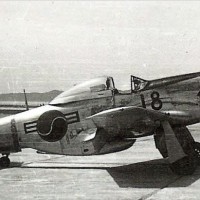
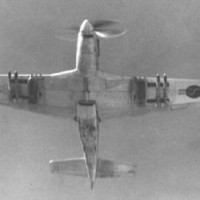
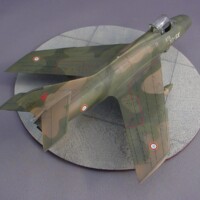

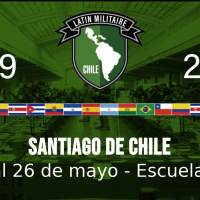
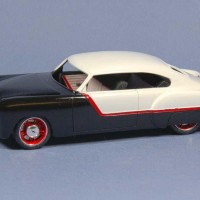
That looks good, Tom. I have the same decal sheet in the dungeon and eventually want to do that plane too. I'm really impressed with the paint. I never thought I'd see an acrylic metallic that could take masking. Have you used any of the AK extreme metal enamels? How does the Vallejo compare?
Haven't used AK. If you let the Vallejo paint cure overnight, there's no problem with masking if you use Tamiya tape (or equivalent) or low-tack drafting tape. It's a very hardy paint.
Thanks
It has become my preferred NMF paint after Tom recommended it and I gave it a go. It isn't as good as Alclad 2 in terms of fine particles, but it is also way more forgiving and less toxic than lacquer which is a consideration for me (Alclad has been hit and miss for me.)
My method differs a bit as I prefer to use Badger Stynylrez black primer as a base with a Tamiya Gloss black final coat. Stynylrez can be lightly sanded and polished which everyone knows is the key to a good NMF coat regardless of the paint you use. Also can be feathered in unlike other acrylic primers. I am not a fan of Vallejo's own primer.
Vallejo's primer thukth.
Thanks
Nice all around presentation, TC...
Really sharp Mustang Tom. What type of CA did you use on the wings?
Zap-A-Gap.
Sharp looking Mustang. I haven't tried filling in panel lines with CA as I'm not sure how long to leave it before sanding. At this very moment I am filling in wing panel lines with stretched sprue on my Hasegawa P-51, very tedious
Great job, Tom. I loved watching "Battle Hymn" as a kid...at a drive-in movie theater to boot. That was the original "big screen". I loved the flying and the shots of the Mustangs. I also met Chappie James once in the summer of 1969 at Eglin AFB...a real gentleman.
One question, I'm assuming that since the Iwo Mustang I'm building is an Inglewood -20NA, the wheel wells would be the WWII standard interior yellow zinc chromate? Thanks...
This might help...or drive you insane...
https://www.britmodeller.com/forums/index.php?/topic/235029538-missouri-armada-p-51d-mustang-documents-and-partial-scratch-from-the-tamiya-148-kit/page/27/&tab=comments#comment-2971913
Extremely helpful - AND enough to drive you insane. Thanks George.
George, I think that helps...or at least gives me enough info to do whatever I want and have the “documentation” to back it up. Thanks a bunch.
Excellent work. The yellow napalm tanks and Taeguk instead of star make it a unique looking Mustang.
I don't blame the F-51D pilots for wishing they had P-47s instead though.
The problem was lack of spare parts and the fact that the P-47Ns in the Hawaii and Georgia ANG had been "run out." A biog effort was made in 1951-52 by FEAF to get a squadron of P-47Ns into Korea.
great model, great movie,great markings, great memories...really hit home
I always though it was a logistics thing for the P-47. P-47 weren't as easy to repair and were more complex than a Mustang. Required more maintenance and as stated they didn't have the spare parts. North America took great pains to simplify their design(P-51) and make it easier to manufacture ...so they could speed up their construction and delivery. Lower costs through economies of scale and again make a a/c easier to repair because of its simplicity. After the war the Air Force was quick to retire P-47s . I am sure the military wanted Republic to be more focused on making F-84s...like everything the bean counters are focused on the dollars and cents. If that makes cents. So pilots flew a a/c that wasn't always suitable to the mission.
Great build and history, as ever. Particularly grateful for all the insight into NMF from author and guys responding! Lots of new learning!
Great post as always - informative! And the Pony looks very nice with those insignia and napalm tanks.